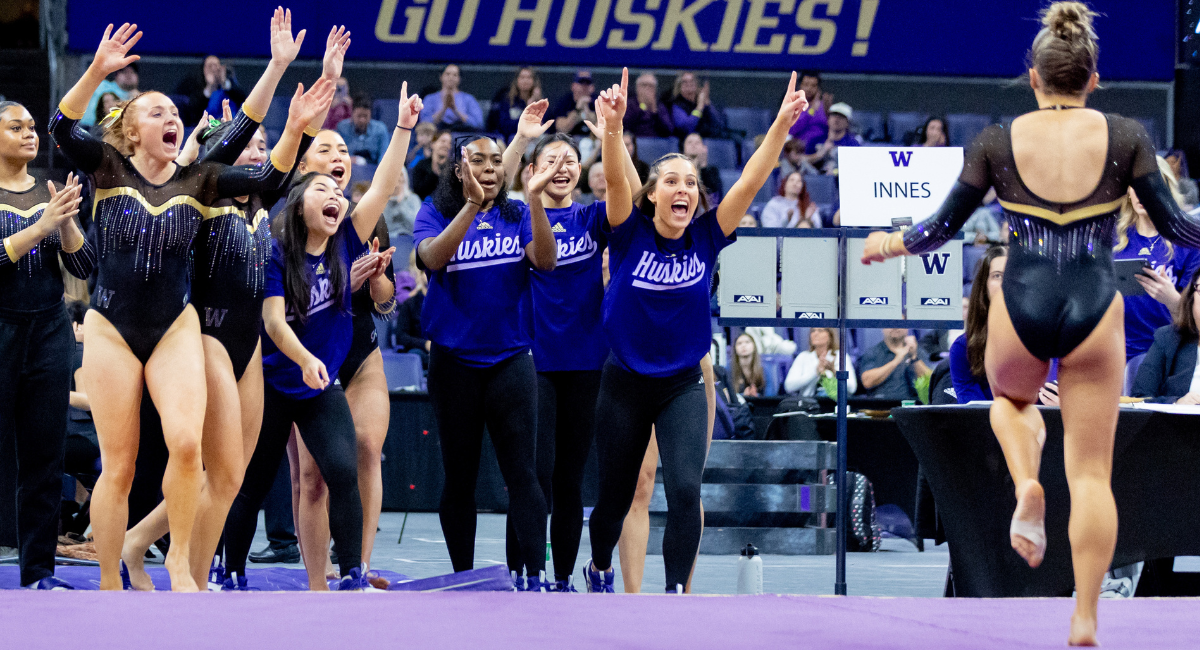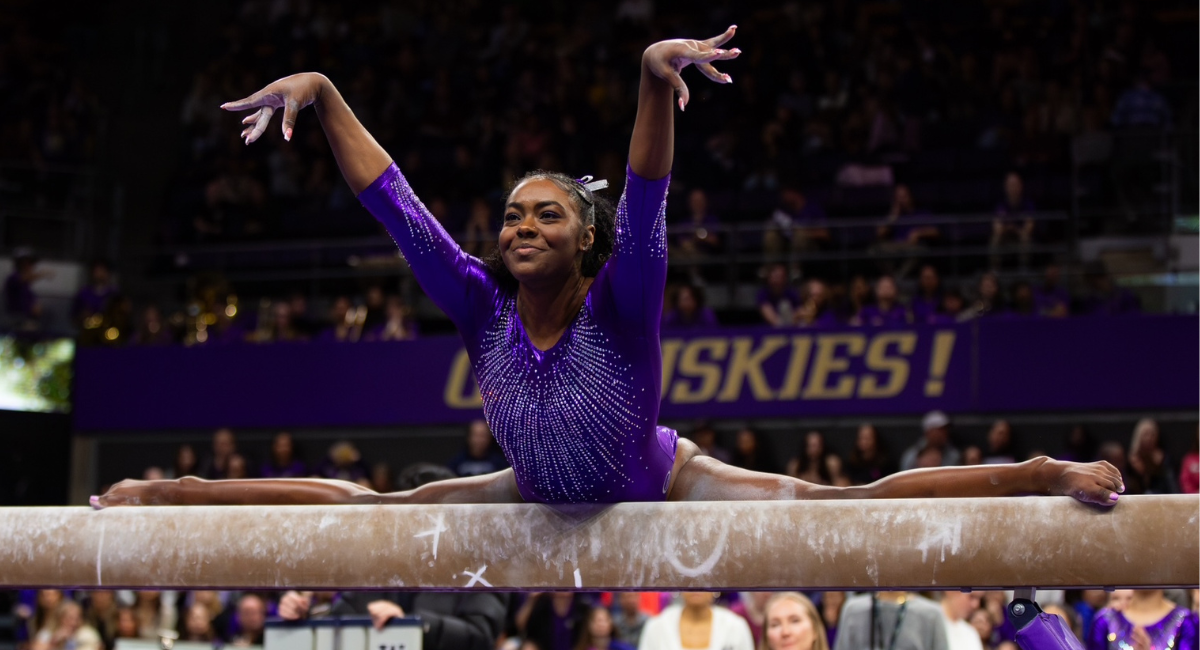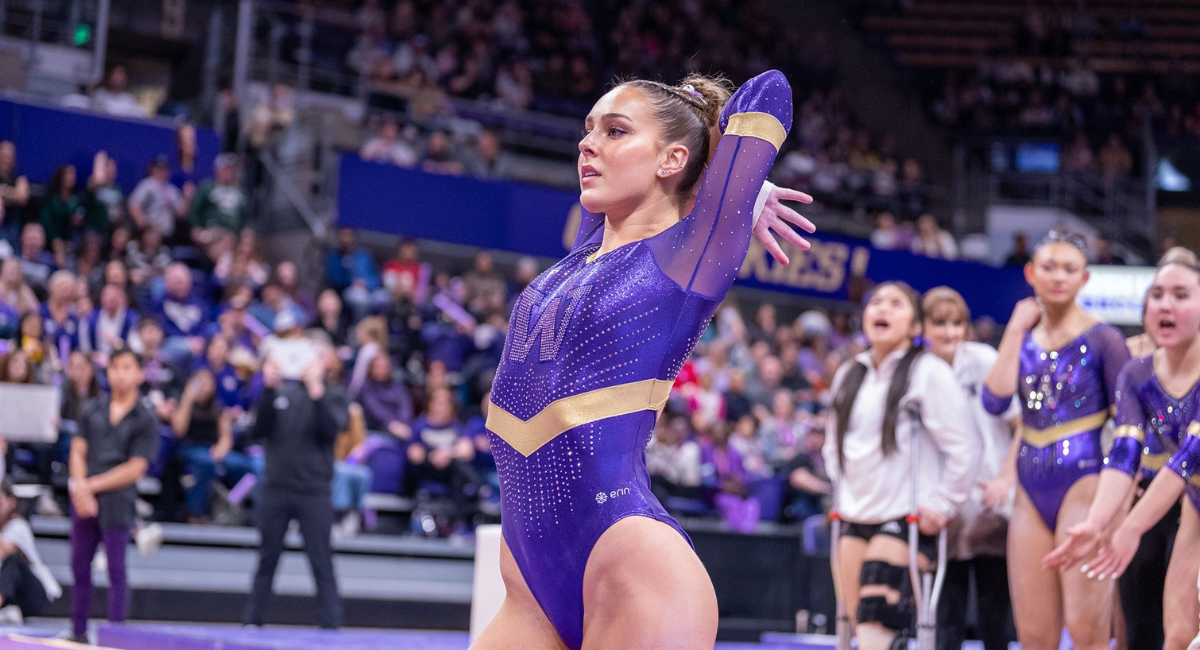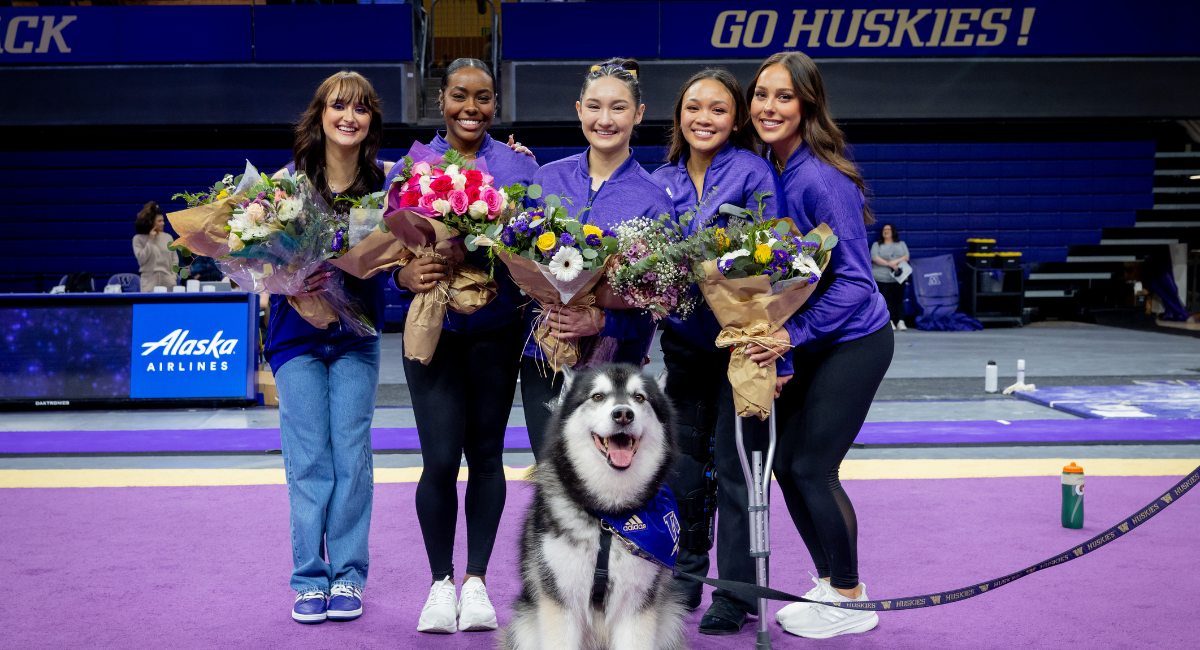
Members of the UW gymnastics team cheer on their teammate at a meet. Photo courtesy UW Athletics.
When they began their gymnastics career, Deiah-Marie Moody and Emily Pires considered it an individual sport. Whether they were tumbling on gym mats as children or leveling up to face their competition in meets, the love of the sport and bettering themselves drew them in.
What they later discovered in college was the team-side of gymnastics. Waiting on the sidelines, they figured out what their teammates needed from them: pep talks, cheers, or a particularly high score to advance to the next competition.
Perhaps it’s no surprise then that the love of their gymnastics team also drew them to study a community-oriented subject in college: public health.
Moody and Pires are both gymnasts at the University of Washington as well as seniors in the School of Public Health. They will be graduating in June having spent a collegiate career as student athletes. They say that gymnastics and their public health studies have complemented each other, inspiring their self-discipline, ability to face adversity, and eagerness to improve their community.
“The lessons I've learned as a public health student and gymnast align and inform each other,” said Pires, who is majoring in public health-global health and is considering going to medical school. “As a student or as an athlete, teamwork is a huge trait I've learned that is incredibly applicable to public health, which is such a collaborative field.”

Moody recalls that one of the most exciting moments of their teamwork in action was at a 2023 NCAA regionals meet, when the UW gymnastics team pulled together to cause an upset. The team was not expected to advance to the regional finals, but they consistently landed high scores on the vault, bars and beam, and some of the scores were their season's best.
Finally, on the floor exercise, they found themselves going head-to-head with Southern Utah, competing for the final spot to advance to the regional finals. As the UW gymnasts stood in the corral, they stared up at the scoreboard, watching their teammates' results. The score of the final routine was just enough to beat Southern Utah, and the whole team started jumping and hugging each other.
“It was a hard competition for us, and no one expected us to make it to the finals, but we did, Moody said. “It means more when you do well and it’s contributing to the whole team.”
Pires, who joined the team as a transfer student from University of California, Davis her junior year, was proud to compete alongside more highly-ranked athletes. But she soon discovered how she could show up for her team in ways that weren’t solely about performance. After experiencing an injury her senior year, Pires faced her first season of being unable to compete. While Pires said she wasn’t prepared for this kind of challenge, she soon realized how resilient she was.
She continued showing up to practice in the gym, where she’d move mats for her teammates, or provide feedback when a coach was busy. She tailored her support to what her teammates needed most in meets, like a pep talk, providing good energy, or supporting the team’s goals by observing performances and offering input. She noticed how similar this work was to the lessons she was learning in public health classes.

“I learned how to contribute to a team when it comes to taking physical ability out of the picture and still have people that count on you,” Pires said. “With gymnastics, I try to bring in the same mentality as what they teach you in public health: understanding how to help people in a way that is serving them rather than fixing them.”
For this team-building work, Pires was named to the Big Ten Sportsmanship team in 2025. The award “means everything to me,” Pires said.
This is the first year that UW athletes have competed in the Big Ten conference, which is renowned for its athletic prowess. This has meant elevated competition for the athletes, as well as travelling across the country, sometimes as far as New Jersey, for meets. These long commutes have also led to additional bonding for the team, Moody and Pires said, with time spent doing homework together, playing games in hotel rooms, and seeing new cities.
The life of a student athlete requires a stringent routine and self-discipline. Moody and Pires start their days in the arena at 7 a.m. They lift weights and then practice from 8 to 11:30 a.m. They might receive treatment after that, then get lunch, shower, and head to classes in the afternoon. After coming home and having dinner, they’ll start on homework, often alongside their other gymnastics student athletes, some of whom they live with.
“Just being an athlete, you learn a lot of discipline and how to stay on top of your work,” said Moody, who is majoring in food systems, nutrition, and health. But she adds it’s just as important to learn how to take care of yourself. “Don't put too much pressure on yourself: put mental health and well-being before all of that.”

Part of how Moody centers well-being is through community building across campus. Moody recommends student athletes get involved with activities that help them meet people outside of athletics. Moody is the vice president of the Black Student Athlete Association at the UW, and has built partnerships with other affinity groups on campus, including the Black Student Union.
Pires recommends student athletes in public health make good use of their professors, who she said were some of the most supportive of her career as a student athlete, as they showed compassion and flexibility if class scheduling conflicts came up when she travelled on the road for meets.
“Public health professors are some of the best people ever,” Pires said. “They care so deeply about the students and want to encourage and support us in going out into the world and making a real difference to serve and help people.”